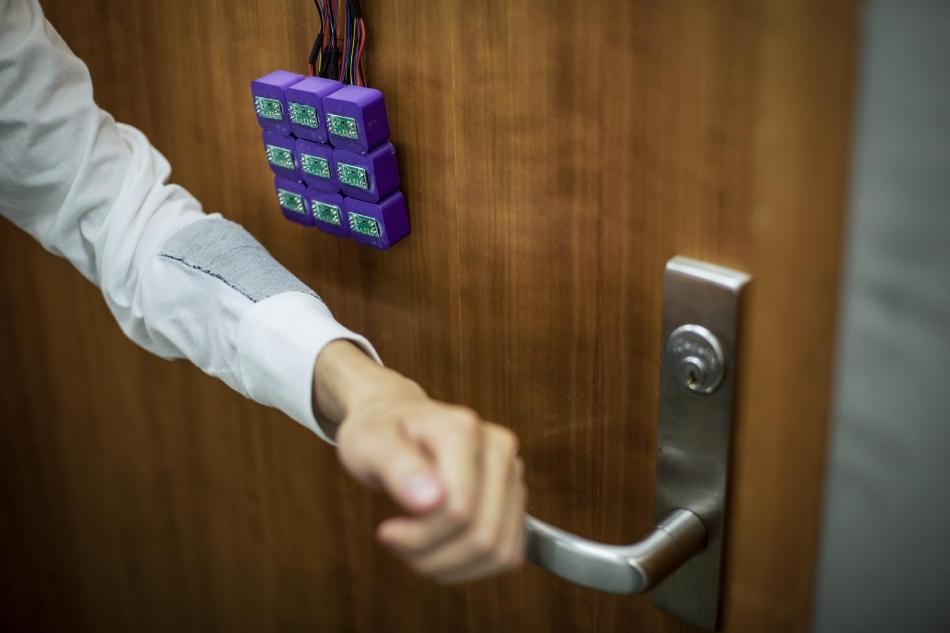Nov 1 2017
Computer scientists at the University of Washington have created a new type of smart fabric that could enable jackets to store invisible passcodes and allow opening of the door to one’s apartment or office.
 Using magnetic properties of conductive thread, University of Washington researchers are able to store data in fabric. In this example, the code to unlock a door is stored in a fabric patch and read by an array of magnetometers. (Credit: Dennis Wise/University of Washington)
Using magnetic properties of conductive thread, University of Washington researchers are able to store data in fabric. In this example, the code to unlock a door is stored in a fabric patch and read by an array of magnetometers. (Credit: Dennis Wise/University of Washington)
The researchers have developed fabrics and fashion accessories that can store data — from identification tags to security codes — without requiring any on-board sensors or electronics.
As detailed in a paper presented October 25 at the Association for Computing Machinery’s User Interface Software and Technology Symposium (UIST 2017), they leveraged formerly unknown magnetic properties of off-the-shelf conductive thread. The data can be read using an instrument embedded in current smartphones to use navigation apps.
This is a completely electronic-free design, which means you can iron the smart fabric or put it in the washer and dryer, you can think of the fabric as a hard disk — you’re actually doing this data storage on the clothes you’re wearing.
Shyam Gollakota, associate professor in the Paul G. Allen School of Computer Science & Engineering and senior author
Most people today integrate conductive thread — embroidery thread that can transport an electrical current — with other types of electronics to make stuffed animals, outfits, or accessories that communicate or light up.
But the UW team realized that this off-the-shelf conductive thread also has magnetic properties that can be controlled to store either digital data or visual information like numbers or letters. It is possible to read this data using a magnetometer, an inexpensive instrument that measures the strength and direction of magnetic fields and is embedded into a majority of smartphones.
“We are using something that already exists on a smartphone and uses almost no power, so the cost of reading this type of data is negligible,” said Gollakota.
In one instance, they stored the passcode to an electronic door lock on a piece of conductive fabric stitched to a shirt cuff. They unlocked the door by waving the cuff before an array of magnetometers.
The researchers also developed fashion accessories like a belt, necklace, tie, and wristband and deciphered the data by swiping a smartphone across them.
They used conventional sewing machines to embroider fabric with off-the-shelf conductive thread, whose magnetic poles begins in an arbitrary order. By rubbing a magnet against the fabric, the team was able to physically line up the poles in either a negative or positive direction, which relate to the 1s and 0s in digital data.
Like hotel card keys, the strength of the magnetic signal diminishes by around 30% over the span of a week, though the fabric can be re-magnetized and re-programmed a number of times. In other stress tests, the fabric patch was able to keep its data even after machine washing, drying, and ironing at temperatures of up to 320 °F.
This is contrary to many smart garments today that still need on-board sensors or electronics to function. That can be difficult if one gets drenched in the rain or forgets to detach those electronics prior to putting them in the washing machine — a potential obstacle to extensive adoption of other wearable technology designs.
The team also showed that the magnetized fabric could be used to interact with a smartphone while it is still inside the pocket. Researchers created a glove with conductive fabric embroidered into its fingertips, which was used to gesture at the smartphone. Each gesture produces a varied magnetic signal that can summon specific actions like playing or pausing music.
With this system, we can easily interact with smart devices without having to constantly take it out of our pockets.
Justin Chan, Allen School doctoral student and lead author
In the team’s tests, the phone was able to identify six gestures — right flick, left flick, downward swipe, upward swipe, click and back click — with 90% accuracy.
Future research aims at developing tailored textiles that produce stronger magnetic fields and can store a higher density of data.
The National Science Foundation, the Alfred P. Sloan Foundation and Google funded this research.
Data Storage and Interaction Using Magnetized Fabric